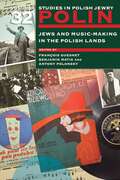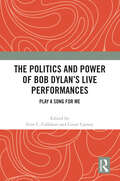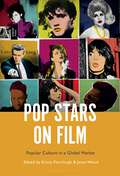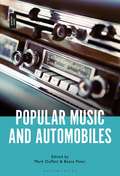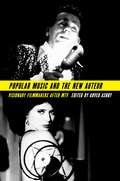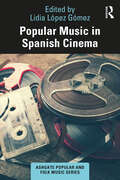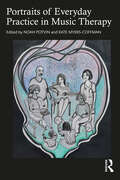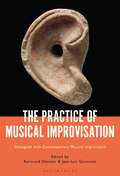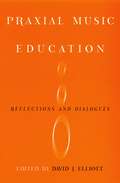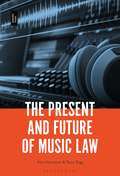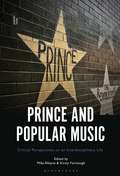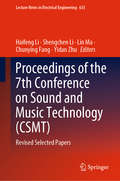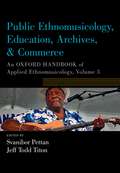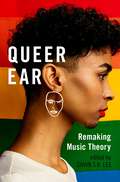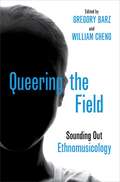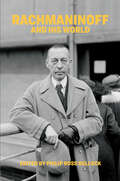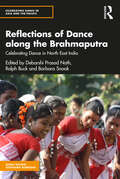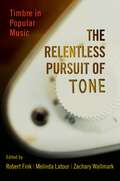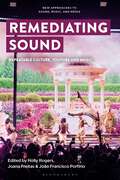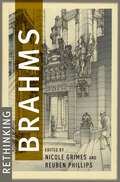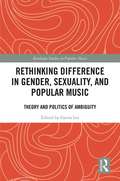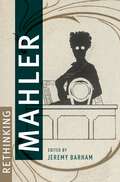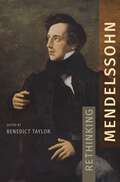- Table View
- List View
Plan of an Orchestra layout (UEB Uncontracted)
This is a labelled plan (seen from above) of a classical orchestra, showing where the various instrumentalists and the conductor are placed on the concert platform. There is a locator dot shown, which will be at the top left of the page when the image is the right way up. The conductor is in the bottom centre of the page; he is the performer who is nearest the audience and stands with his back to them, facing the rest of the players further up the page. The various areas occupied by the instruments are labelled. The stringed instruments occupy the bottom third of the page with the woodwind and brass instruments further up the page. The percussion instruments are at the top left of the page.
Polin: Jews and Music-Making in the Polish Lands (Polin: Studies in Polish Jewry #32)
With its five thematic sections covering genres from cantorial to classical to klezmer, this pioneering multi-disciplinary volume presents rich coverage of the work of musicians of Jewish origin in the Polish lands. It opens with the musical consequences of developments in Jewish religious practice: the spread of hasidism in the eighteenth century meant that popular melodies replaced traditional cantorial music, while the greater acculturation of Jews in the nineteenth century brought with it synagogue choirs. Jewish involvement in popular culture included performances for the wider public, Yiddish songs and the Yiddish theatre, and contributions of many different sorts---technical and commercial as well as creative---in the interwar years. Chapters on the classical music scene cover Jewish musical institutions, organizations, and education; individual composers and musicians; and a consideration of music and Jewish national identity. One section is devoted to the Holocaust as reflected in Jewish music, and the final section deals with the afterlife of Jewish musical creativity in Poland, particularly the resurgence of interest in klezmer music. The essays in this collection do not attempt to to define what may well be undefinable---what ‘Jewish music’ is. Rather, they provide an original and much-needed exploration of the activities and creativity of ‘musicians of the Jewish faith’.CONTRIBUTORS: Eliyana R. Adler, Michael Aylward, Sławomir Dobrzański, Paula Eisenstein-Baker, Beth Holmgren, Sylwia Jakubczyk-Ślęczka, Daniel Katz, James Loeffler, Michael Lukin, Filip Mazurczak, Bożena Muszkalska, Julia Riegel, Ronald Robboy, Robert Rothstein, Joel E. Rubin, Adam J. Sacks, Amanda (Miryem-Khaye) Seigel, Eleanor Shapiro, Carla Shapreau, Tamara Sztyma, Bella Szwarcman-Czarnota, Joseph Toltz, Maja Trochimczyk, Magdalena Waligórska, Bret Werb, Akiva Zimmerman
The Politics and Power of Bob Dylan’s Live Performances: Play a Song for Me
Ephemeral by nature, the concert setlist is a rich, if underexplored, text for scholarly research. How an artist curates a show is a significant aspect of any concert’s appeal. Through the placement of songs, variations in order, or the omission of material, Bob Dylan’s setlists form a meta-narrative speaking to the power and significance of his music. These essays use the setlists from concerts throughout Dylan’s career to study his approach to his material from the 1960s to the 2020s. These chapters, from various disciplinary perspectives, illustrate how the concert setlist can be used as a source to explore many aspects of Dylan’s public life. Finally, this collection provides a new method to examine other musicians across genres with an interdisciplinary approach to setlists and the selectivity of performance. Unique in its approach and wide-ranging scholarly methodology, this book deepens our understanding of Bob Dylan, the performer.
Pop Stars on Film: Popular Culture in a Global Market
Pop stars have provided audiences with performative moments that have become ingrained in popular consciousness. They are a lens through which deeper understandings about race, gender, politics, history and the artistic process can be understood. When combined with the most affective of mediums – cinema, the combination can be both thrilling and alarming.From the relatively early days of cinema, figures from the world of popular music have made forays into acting and contributed cameo appearances. From Little Richard and Kylie Minogue to Nick Cave and Tom Waits, Pop Stars On Film: Popular Culture in a Global Market offers a collection of essays on some of the most influential international performances from a diverse range of cultural icons. The book considers industry shifts, access and diversity, but also the notion of cultural appropriation, audience appeal, marketing and demographics. Perhaps most importantly, the publication will look at what happens when cultures collide and coalesce.
Popular Music and Automobiles
Particularly since the 1950s, cars and popular music have been constantly associated. As complementary goods and intertwined technologies, their relationship has become part of a widely shared experience-one that connects individuals and society, private worlds and public spheres. Popular Music and Automobiles aims to unpack that relationship in more detail. It explores the ways in which cars and car journeys have shaped society, as well as how we have shaped them. Including both broad synergies and specific case studies, Popular Music and Automobiles explores how attention to an ongoing relationship can reveal insights about the assertion and negotiation of identity. Using methods of enquiry that are as diverse as the topics they tackle, its contributors closely consider specific genders, genres, places and texts.
Popular Music and the New Auteur: Visionary Filmmakers after MTV
MTV utterly changed the movies. Since music television arrived some 30 years ago, music videos have introduced filmmakers to a new creative vocabulary: speeds of events changed, and performance and mood came to dominate over traditional narrative storytelling. Popular Music and the New Auteur charts the impact of music videos on seven visionary directors: Martin Scorsese, Sofia Coppola, David Lynch, Wong Kar-Wai, the Coen brothers, Quentin Tarantino, and Wes Anderson. These filmmakers demonstrate a fresh kind of cinematic musicality by writing against pop songs rather than against script, and allowing popular music a determining role in narrative, imagery, and style. Featuring important new theoretical work by some of the most provocative writers in the area today, Popular Music and the New Auteur will be required reading for all who study film music and sound. It will be particularly relevant for readers in popular music studies, and its intervention in the ongoing debate on auteurism will make it necessary reading in film studies.
Popular Music in Spanish Cinema (Ashgate Popular and Folk Music Series)
Popular Music in Spanish Cinema analyses the aesthetics and stylistic development of soundtracks from national productions, considering how political instability and cultural diversity in Spain determined the ways of making art and managing culture. As a pioneering study in this field, the chronologically structured approach of this book provides readers with a complete overview of Spanish music and connects it to the complex historical events that conditioned Spanish culture throughout the 20th century to the present day, from the Second Republic, the Spanish Civil war, and the dictatorship through to democracy. The book enables an understanding of the relationships between the recording and film production industries, the construction of collective imagination, the formulation of new stereotypes, semiotic meanings within film music and the musical exchanges between national and international cinema. This volume is an essential read for students and academics in the field of musicology, ethnomusicology and history as well as those interested in the study of diverse musical styles such as copla, zarzuela, flamenco, jazz, foxtrot, pop and rock and how they have been used in Spanish films throughout history.
Portraits of Everyday Practice in Music Therapy
Portraits of Everyday Practice in Music Therapy is an edited volume of case studies providing music therapy students and new professionals with critical reflections on everyday clinical practice across a variety of treatment settings, theories, approaches, and cultural contexts. These case studies articulate the important foundational work occurring around clinical breakthroughs to illustrate less of what music therapy could be given extraordinary circumstances and more of what music therapy frequently is given realistic circumstances. Additionally, each author explores the impacts of cultural values, expectations, and roles on clinical contexts through examinations of their sociocultural identities and how they intersected with those with whom they worked. Discussion prompts at the end of chapters help readers engage in similar reflective practices and sustain engagement with introduced concepts and ideas. By providing ecological real-world contexts for practice and culturally reflexive lenses through which to understand how therapeutic processes evolved, music therapy students and professionals can be better prepared for the authenticity and complexity of everyday clinical work.
The Practice of Musical Improvisation: Dialogues with Contemporary Musical Improvisers
Over several years, Bertrand Denzler and Jean-Luc Guionnet have interviewed approximately 50 musicians from various backgrounds about their practice of musical improvisation. Musicians include both the very experienced such as Sophie Agnel, Burkhard Beins, John Butcher, Rhodri Davies, Bill Dixon, Phil Durrant, Axel Dörner, Annette Krebs, Daunik Lazro, Mattin, Seijiro Murayama, Andrea Neumann, Jérôme Noetinger, Evan Parker, Eddie Prévost and Taku Unami, as well as those newer to the field. Asked questions on topics such as the mental processes behind a collective improvisation, the importance of the human factor in improvisation, the strategies used and the way musical decisions are made, the interviewees highlight the habits and customs of a practice, as experienced by those who invent it on a daily basis. The interviews were carefully edited in order to produce a sort of grand discussion that draws an incomplete map of the blurred territory of contemporary improvised music.
Praxial Music Education: Reflections and Dialogues
Praxial Music Education is a collection of essays by nineteen internationally recognized scholars in music education. Each essay offers critical reflections on a key topic in contemporary music education. The starting point of each essay, and the unifying thread of this collection, is the "praxial" philosophy of music education explained in Elliott's Music Matters: A New Philosophy of Music Education (OUP, 1995). This philosophy argues for a socially and artistically grounded concept of music and music education, challenging the field's traditional "absolutist" foundations. Praxial Music Education is both a critical companion to Music Matters, and an independent text on contemporary issues in music education. Among the themes discussed are multicultural music education, the nature of musical understanding, early childhood music education, the nature and teaching of music listening, music curriculum development, and musical creativity. Praxial music education is a living theory. This unique collection will not only enrich discussions that already use Music Matters as their core, but will globalize current discussions and applications of the praxial philosophy and emphasize the positive and practical values of collaborative efforts in music education.
The Present and Future of Music Law
The music business is a multifaceted, transnational industry that operates within complex and rapidly changing political, economic, cultural and technological contexts. The mode and manner of how music is created, obtained, consumed and exploited is evolving rapidly. It is based on relationships that can be both complimentary and at times confrontational, and around roles that interact, overlap and sometimes merge, reflecting the competing and coinciding interests of creative artists and music industry professionals. It falls to music law and legal practice to provide the underpinning framework to enable these complex relationships to flourish, to provide a means to resolve disputes, and to facilitate commerce in a challenging and dynamic business environment. The Present and Future of Music Law presents thirteen case studies written by experts in their fields, examining a range of key topics at the points where music law and the post-digital music industry intersect, offering a timely exploration of the current landscape and insights into the future shape of the interface between music business and music law.
Prince and Popular Music: Critical Perspectives on an Interdisciplinary Life
Prince's position in popular culture has undergone only limited academic scrutiny. This book provides an academic examination of Prince, encompassing the many layers of his cultural and creative impact. It assesses Prince's life and legacy holistically, exploring his multiple identities and the ways in which they were manifested through his recorded catalogue and audiovisual personae. In 17 essays organized thematically, the anthology includes a diverse range of contributions - taking ethnographic, musicological, sociological, gender studies and cultural studies approaches to analysing Prince's career.
Proceedings of the 7th Conference on Sound and Music Technology: Revised Selected Papers (Lecture Notes in Electrical Engineering #635)
The book presents selected papers that have been accepted at the seventh Conference on Sound and Music Technology (CSMT) in December 2019, held in Harbin, Hei Long Jiang, China. CSMT is a domestic conference focusing on audio processing and understanding with bias on music and acoustic signals. The primary aim of the conference is to promote the collaboration between art society and technical society in China. The organisers of CSMT hope the conference can serve as a platform for interdisciplinary research. In this proceeding, the paper included covers a wide range topic from speech, signal processing and music understanding, which demonstrates the target of CSMT merging arts and science research together.
Public Ethnomusicology, Education, Archives, & Commerce: An Oxford Handbook of Applied Ethnomusicology, Volume 3 (Oxford Handbooks)
The seven ethnomusicologists who contributed to this volume discuss the role and impact of applied ethnomusicology in a variety of public and private sectors, including the commercial music industry, archives and collections, public folklore programs, and music education programs at public schools. Public Ethnomusicology, Education, Archives, and Commerce is the third of three paperback volumes derived from the original Oxford Handbook of Applied Ethnomusicology. The Handbook can be understood as an applied ethnomusicology project: as a medium of getting to know the thoughts and experiences of global ethnomusicologists, of enriching general knowledge and understanding about ethnomusicologies and applied ethnomusicologies in various parts of the world, and of inspiring readers to put the accumulated knowledge, understanding, and skills into good use for the betterment of our world.
Queer Ear: Remaking Music Theory
Through provisional, idiosyncratic, and non-normative listening practices, Queer Ear: Remaking Music Theory counters music theory's continuing tendencies towards rationality, unity, unilinearity, teleology, and logical certainty. In this volume, editor Gavin S.K. Lee brings together a diverse group of music theorists who issue queer challenges to both music theory and musicology and show that queerness is integral to music-theoretical practice. These investigations of the "queer ear" and queer soundings, while drawing upon a broad range of approaches, are united by the repurposing of "hard" music-theoretical apparatuses, as well as "soft" apparatuses like narratology and cultural theory, for queer ends. Such repurposings contribute to the search for general principles--or a theory--of queering that counters mainstream music theory's proclivities, instead encouraging everyone to experiment with queer ways of listening. Through the lenses of queer temporality, queer narratology, and queer music analysis, the essays examine a wide variety of artists and composers, including Sun Ra, Cowell, Czernowin, Henze, Schubert, and Schumann; theories ranging from Schenker to queer shame, disability studies, and posthumanism; and authors such as Edward Cone and Edward Prime-Stevenson. Together, they rethink the field's major tenets, examine hidden histories, and view listening practices from the perspective of non-normative subjectivities. Ultimately, Queer Ear works to queer the field of music theory while paying heed to the ways in which music theory intersects with diverse, embodied LGBTQ lives.
Queering the Field: Sounding Out Ethnomusicology
Drawing on ethnographic research and often deeply personal experiences with musical cultures, Queering the Field: Sounding out Ethnomusicology unpacks a history of sentiment that veils the treatment of queer music and identity within the field of ethnomusicology. The thematic structure of the volume reflects a deliberate cartography of queer spaces in the discipline-spaces that are strongly present due to their absence, are marked by direct sonic parameters, or are called into question by virtue of their otherness. As the first large-scale study of ethnomusicology's queer silences and queer identity politics, Queering the Field directly addresses the normativities currently at play in musical ethnography (fieldwork, analysis, performance, transcription) as well as in the practice of musical ethnographers (identification, participation, disclosure, observation, authority). While rooted in strong narrative convictions, the authors frequently adopt radicalized voices with the goal of queering a hierarchical sexual binary. The essays in the volume present rhetorical and syntactical scenarios that challenge us to read in prescient singular ways for future queer writing and queer thought in ethnomusicology.
Rachmaninoff and His World (Bard Music Festival)
A biography of composer Sergei Rachmaninoff, published in collaboration with the Bard Music Festival. One of the most popular classical composers of all time, Sergei Rachmaninoff (1873–1943) has often been dismissed by critics as a conservative, nostalgic holdover of the nineteenth century and a composer fundamentally hostile to musical modernism. The original essays collected here show how he was more responsive to aspects of contemporary musical life than is often thought, and how his deeply felt sense of Russianness coexisted with an appreciation of American and European culture. In particular, the essays document his involvement with intellectual and artistic circles in prerevolutionary Moscow and how the form of modernity they promoted shaped his early output. This volume represents one of the first serious explorations of Rachmaninoff’s successful career as a composer, pianist, and conductor, first in late Imperial Russia, and then after emigration in both the United States and interwar Europe. Shedding light on some unfamiliar works, especially his three operas and his many songs, the book also includes a substantial number of new documents illustrating Rachmaninoff’s celebrity status in America.
Reflections of Dance along the Brahmaputra: Celebrating Dance in North East India (Celebrating Dance in Asia and the Pacific)
This volume brings a critical lens to dance and culture within North East India. Through case studies, first-hand accounts, and interviews, it explores unique folk dances of Indigenous communities of North East India that reflect diverse journeys, lifestyles, and connections within their ethnic groups, marking almost every ritual and festival. Dance for people of North East India, as elsewhere, is also a way of declaring, establishing, celebrating, and asserting humans' relationship with nature. The book draws attention to the origins and special circumstances of dances from North East India. It discusses a range of important folk-dance forms alongside classical dance forms in North East India, with a focus on Sattriya dance. The chapters examine how these dance forms play an important role in the region’s socio-cultural, economic, and political life, intertwining religion and the arts through music, dance, and drama. Further, they also explore how folk dance cultures in North East India have never been relegated to the background, never considered secondary, aesthetically, or otherwise, but have become expressions of political and cultural identity. An evocative work, this volume will be of interest to students and researchers of pedagogy, choreography, community dance practice, theatre and performance studies, social and cultural studies, aesthetics, interdisciplinary arts, and more. It will be an invaluable resource for artists and practitioners working in dance schools and communities.
The Relentless Pursuit of Tone: Timbre in Popular Music
The Relentless Pursuit of Tone: Timbre in Popular Music assembles a broad spectrum of contemporary perspectives on how "sound" functions in an equally wide array of popular music. Ranging from the twang of country banjoes and the sheen of hip-hop strings to the crunch of amplified guitars and the thump of subwoofers on the dance floor, this volume bridges the gap between timbre, our name for the purely acoustic characteristics of sound waves, and tone, an emergent musical construct that straddles the borderline between the perceptual and the political. Essays engage with the entire history of popular music as recorded sound, from the 1930s to the present day, under four large categories. "Genre" asks how sonic signatures define musical identities and publics; "Voice" considers the most naturalized musical instrument, the human voice, as racial and gendered signifier, as property or likeness, and as raw material for algorithmic perfection through software; "Instrument" tells stories of the way some iconic pop music machines-guitars, strings, synthesizers-got (or lost) their distinctive sounds; "Production" then puts it all together, asking structural questions about what happens in a recording studio, what is produced (sonic cartoons? rockist authenticity? empty space?) and what it all might mean.
Remediating Sound: Repeatable Culture, YouTube and Music (New Approaches to Sound, Music, and Media)
Remediating Sound studies the phenomena of remixing, mashup and recomposition: forms of reuse and sampling that have come to characterise much of YouTube's audiovisual content. Through collaborative composition, collage and cover songs to reaction videos and political activism , users from diverse backgrounds have embraced the democratised space of YouTube to open up new and innovative forms of sonic creativity and push the boundaries of audiovisual possibilities. Observing the reciprocal flow of influence that runs between various online platforms, 12 chapters position YouTube as a central hub for the exploration of digital sound, music and the moving image. With special focus on aspects of networked creativity that remain overlooked in contemporary scholarship, including library music, memetic media, artificial intelligence, the sonic arts and music fandom, this volume offers interdisciplinary insight into contemporary audiovisual culture.
Rethinking Bach
Johann Sebastian Bach has loomed large in the imagination of scholars, performers, and audiences since the late nineteenth century.This new book, edited by veteran Bach scholar Bettina Varwig, gathers a diverse group of leading and emerging Bach researchers as well as a number of contributors from beyond the core of Bach studies. The book's fourteen chapters engage in active 'rethinking' of different topics connected with Bach; the iconic name which broadly encompasses the historical individual, the sounds and afterlives of his music, as well as all that those four letters came to stand for in the later popular and scholarly imagination. In turn, challenging the fundamental assumptions about the nineteenth-century Bach revival, the rise of the modern work concept, Bach's music as a code, and about editions of his music as monuments. Collectively, these contributions thus take apart, scrutinize, dust off and reassemble some of our most cherished narratives and deeply held beliefs about Bach and his music. In doing so, they open multiple pathways towards exciting future modesof engagement with the composer and his legacy.
Rethinking Brahms
As one of the most significant and widely performed composers of the nineteenth century, Brahms continues to command our attention. Rethinking Brahms counterbalances prevailing scholarly assumptions that position him as a conservative composer (whether musically or politically) with a wide-ranging exploration and re-evaluation of his significance today. Drawing on German- and English-language scholarship, it deploys original approaches to his music and pursues innovative methodologies to interrogate the historical, cultural, and artistic contexts of his creativity. Empowered by recent theoretical work on form and tonality, it offers fresh analytical insights into his music, including a number of corpus studies that interrogate the relationships between Brahms and other composers, past and present. The book brings into sharp focus the productive tension that exists between the perceived fixedness of musical texts and the ephemerality of performance by considering how historical and modern performers shape established understandings of Brahms and his music. Rethinking Brahms invites the reader to hear familiar pieces anew as they are refracted through historical, artistic, and philosophical prisms. Bringing us up to the present day, it also gives sustained attention to the resounding impact of Brahms's compositions on new music by exploring works by recent composers who have engaged deeply with his oeuvre. Combining awareness of overarching contexts with perceptive insights into Brahms's music, this book enlivens our understanding of Brahms, providing a dynamic, multifaceted, complex, and invigoratingly fresh portrait of the composer.
Rethinking Difference in Gender, Sexuality, and Popular Music: Theory and Politics of Ambiguity (Routledge Studies in Popular Music)
In studies of gender and sexuality in popular music, the concept of difference is often a crucial analytic used to detect social agency; however, the alternative analytic of ambiguity has never been systematically examined. While difference from heterosexual norms is taken to be the multivalent sign of resistance, oppression, and self-invention, it can lead to inflated claims of the degree and power of difference. This book offers critically-oriented case studies that examine the theory and politics of ambiguity. Ambiguity means that there are both positive and negative implications in any gender and sexuality practices, both sameness and difference from heteronormativity, and unfixed possibility in the diverse nature of discourse and practice (rather than just "difference" among fixed multiplicities). Contributors present a diverse array of approaches through music, sound, psyche, body, dance, performance, race, ethnicity, power, discourse, and history. A wide variety of popular music genres are broached, including gay circuit remixes, punk rock, Goth music, cross-dress performance, billboard 100 songs, global pop, and nineteenth-century minstrelsy. The authors examine the ambiguities of performance and reception, and address the vexed question of whether it is possible for genuinely new forms of gender and sexuality to emerge musically. This book makes a distinctive contribution to studies of gender and sexuality in popular music, and will be of interest to fields including Popular Music Studies, Musicology/Ethnomusicology, Cultural Studies, Queer Studies, and Media Studies.
Rethinking Mahler
As one of the most popular classical composers in the performance repertoire of professional and amateur orchestras and choirs across the world, Gustav Mahler continues to generate significant interest, and the global appetite for his music, and for discussions of it, remains large. Editor Jeremy Barham brings together leading and emerging scholars in the field to explore Mahler's relationship with music, media, and ideas past and present, addressing issues in structural analysis, performance, genres of stage, screen and literature, cultural movements, aesthetics, history/historiography and temporal experience. Rethinking Mahler counterbalances prevailing scholarly assumptions and preferences that configure Mahler as proto-modernist, with hitherto neglected consideration of his debt to, and his re-imagining of, the legacies of his own historical past. Over the course of 17 chapters drawing from a variety of disciplinary perspectives, the book pursues ideas of nostalgia, historicism and 'pastness' in relation to an emergent modernity and subsequent musical-cultural developments, yielding a wide-ranging exploration and re-evaluation of Mahler's works, their historical reception and understanding, and their resounding impact within diverse cultural contexts. Rethinking Mahler will be an essential resource for scholars and students of Mahler and late Romantic era music more generally, and will also find an audience among the many devotees of Mahler's music.
Rethinking Mendelssohn
As one of the foremost composers, conductors, and pianists of the nineteenth century, Felix Mendelssohn played a fundamental role in the shaping of modern musical tastes through his contributions to the early music revival and the formation of the Austro-German musical canon. His career allows for a remarkable meeting point for critical engagement with a host of crucial issues in the last two centuries of music history, including the relation between musical meaning and social function, programmatic and absolute music, notions of classicism and Romanticism, modernism and historicism. It also serves as a pertinent case-study of the roles political ideology, racism, and musical ignorance may play in creating and perpetuating a composer's posthumous reception. Fittingly, Rethinking Mendelssohn focuses on critical engagement with the composer's music and aesthetics, and on the interpretation of his works in relation to contemporaneous culture. Building on the renaissance in Mendelssohn scholarship of the last two decades, Rethinking Mendelssohn sets a fresh and exciting tone for research on the composer. Opening new ways of understanding Mendelssohn and setting the future direction of Mendelssohn studies, the contributing scholars pay particular attention to Mendelssohn's contested views on the relationship between art and religion, analysis of Mendelssohn's instrumental music in the wake of recent controversies in Formenlehre, and the burgeoning interest in his previously neglected contribution to the German song.

